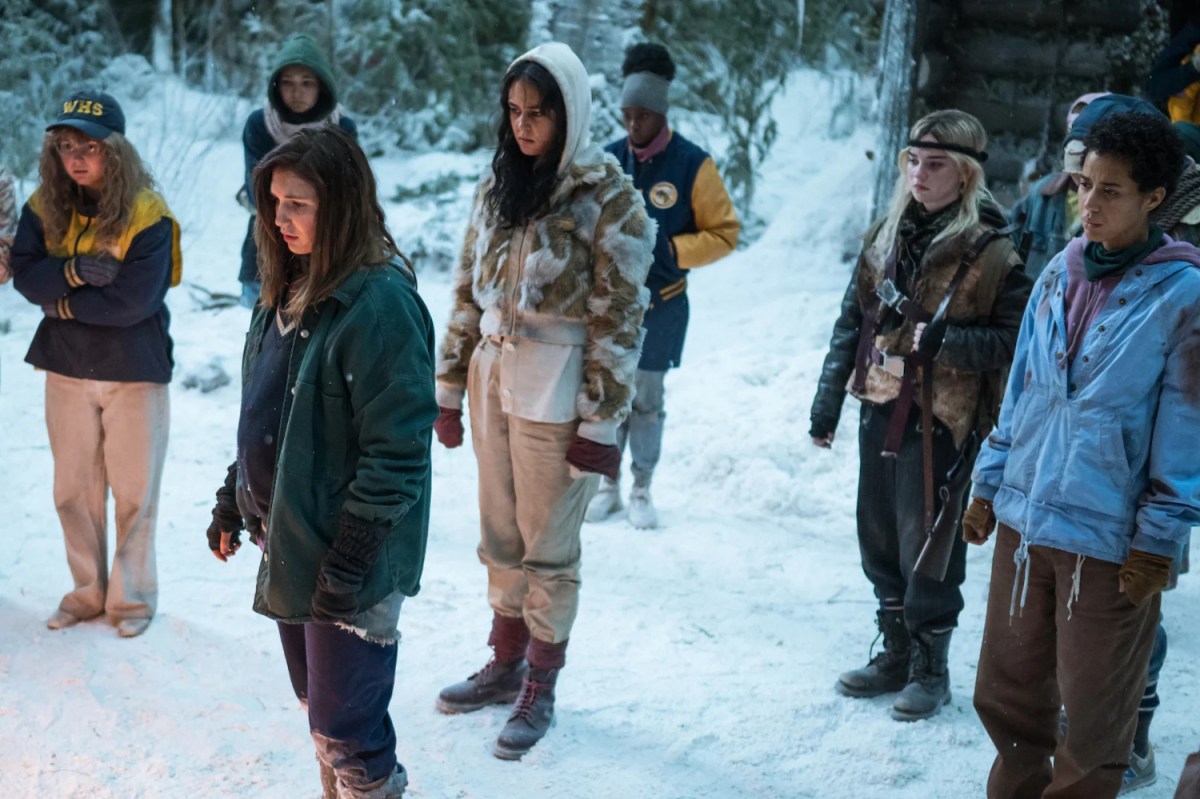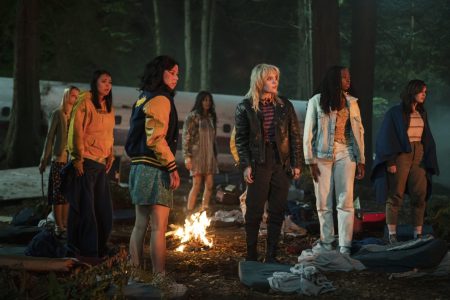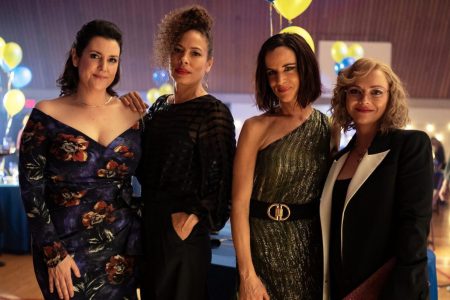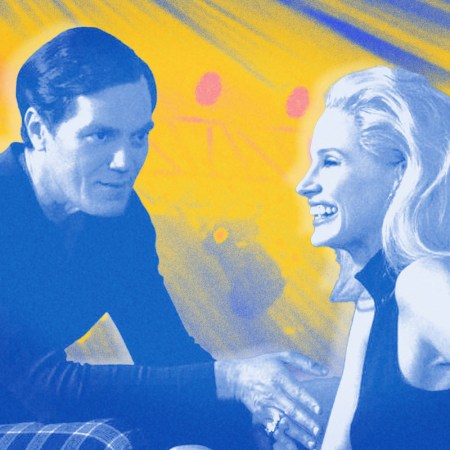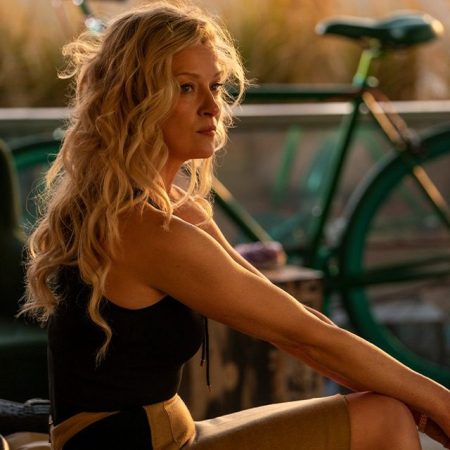If you paid attention in high school English class during Lord of the Flies, you’ll recall the spectral “Beast” that the marooned boys feared and most grew to worship turned out to be a dead fighter pilot. Shot down in a dogfight, the pilot ejected from his wounded plane and fell to the island. His parachute wound up tangled in trees in such a way that, when the wind blew, his rotting body gyrated. To the boys, who at first only observed the scene at night, The Beast seemed to lunge at them menacingly, but when the Christlike character Simon stumbles upon the combat kill during the day, what he suspected of his peers all along is revealed to be the truth. Jack and his rogue sect of malevolent boys believed The Beast gave them license to engage in brutality; however, as Simon wished to communicate, it was actually mankind’s innate savagery, symbolized by the warring pilot’s carcass, that triggered their aggression, not some controlling, external force of evil.
When Simon tries to deliver this dose of reality, which could have reinstated the boys’ civil selves, he’s mistaken for The Beast and struck down by his frenzied classmates. Describing the killing, William Golding wrote, “There were no words, and no movements but the tearing of teeth and claws.”
Just as the boys in Flies slowly submitted to their destructive impulses, the stranded girls soccer team of the Showtime series Yellowjackets have been on a predictable, subversive collision course with their own female-branded barbarity in the winter of 1997, which looks strikingly similar to that of their male counterparts from the novel that inspired the show. Women can be from the planet named after the Roman god of war, too, according to Yellowjackets’ betrothed co-creators and producers, Ashley Lyle and Bart Nickerson. They scoffed at the idea that, in similar circumstances as the Flies boys, a group of teen girls would merely “collaborate to death” — something a man commented underneath an online article about a possible all-female Hollywood reimagining of the book. Challenging that concept, through season two, episode seven of the series, Lyle, Nickerson and third showrunner Jonathan Lisco have already generated numerous scenes of female-perpetrated assault, murder and cannibalism. Depictions of their growing inhumanity are expected to multiply, considering chronology-bending scene flashes that have already aired and dialogue-based references to a thus-far unseen past during the show’s 2021 timeline of events.
“Yellowjackets” Is a Female “Lord of the Flies” That Reminds Us Just How Brutal Teen Girls Can Be
You don’t need to survive a plane crash to understand the savagery these girls are capable ofAt the center of the girls’ transformation and adherence to “the wilderness” — which, like The Beast in Flies, is a nebulous power that guides the kids to both madness and safety, while apparently requiring blood sacrifices for the privilege — is Charlotte “Lottie” Matthews. Early in the series it’s revealed that Lottie lives with schizophrenia and was prescribed medication to mitigate the neurological disorder’s hallucination symptoms. But with no CVS around the corner after the spring ’96 plane crash and subsequent stranding in the woods, Lottie eventually runs out of pills. Her “visions” return and she believes they are predictive and originate from within a wilderness that’s teeming with mysticism. Lottie convinces a growing cadre of girls that the force can help them survive. She achieves this in part through her knack for helping members of the group cope with their severe stress, like when she soothingly instructs Travis to breathe deeply, in through his nose, then out of his mouth, when he suffers a panic attack. Travis, too, becomes a Lottie disciple and adherent of the wilderness’ power, a disposition he maintains to some degree until his accidental death 24-ish years after returning home from the Canadian outback. He leaned on Lottie for solutions to his emotional struggles into adulthood, while she leveraged her knowledge of mental illness treatments to become a wellness guru and leader of what she calls in 2021 an “intentional community.” Though the group has the makings of a cult, Lottie tells Natalie that she helps turn her community members’ “suffering into strength” so that they can live life as their “best selves.”
But looming over everything Lottie says and does across both timelines is a question of whether or not she is being influenced by that ominous force, “the wilderness,” even in her helpful actions toward others that appear rooted in compassion. In the series, Lyle, Nickerson and Lisco are navigating a balancing act they themselves have rolled out. On one side: What is feasible for this story from our accepted reality? The other: How can that coexist with phenomena that may be perpetuated by supernatural entities? Getting this right, where one way or the other the audience buys the outcome conjured up by the showrunner triumvirate, will determine the overall success of the series.
At times it already feels like the show is purposefully overstuffed so that it might better stand out in the endless sea of content that exists in this post-streaming entertainment universe. As I wrote last year after season one in an InsideHook essay where I wondered about the death of prestige TV, “It wasn’t enough for Yellowjackets to rely on ’90s nostalgia and allusions (for now) to cannibalism.” That would’ve been cool enough to watch, but the producers “also introduced mysticism and the occult to a program that otherwise…is grounded in gory realism.” This could prove problematic in the long term. With the conjoined emergence of both the real and surreal, viewers have to calibrate what they can embrace as plausibly authentic plot points of the story. So far there’s been visual evidence that the unexplained in Yellowjackets could very well be explained. But as some characters further commit to the supernatural elements of their surroundings, in spite of pleas from others to pass strange events off as simple coincidences, the audience is challenged to make that same commitment as well. If viewers can’t reconcile the existence of both the scientifically possible and impossible in the series, that could damage the plot’s sustainability in their eyes.
Lottie is the primary character (with Taissa being a secondary one) through which the show’s messaging about what is practical within the Yellowjackets universe is communicated. Lyle, Nickerson and Lisco will have to land this plane much better than did the pilot of the plane carrying the soccer team in the series’ second episode. So far they deserve commendations for getting some of the “real” part right in regards to Lottie’s wellness approaches — though doing so makes it harder to push the audience across a spectrum of acceptance toward more paranormal goings on.
“Probably the best first example of a really good approach is when we see her, in the earlier timeline in the woods, calming Travis down from a panic attack,” says Dr. Kaleb Jensen, a licensed clinical psychologist in California. Jensen currently focuses on pediatric neuropsychological assessment at the Pasadena practice Insight Collective, but in the past has worked with teens in psychiatric hospitals and treated patients with mindfulness practices, such as the breathing technique Lottie employs in the moment of crisis with Travis during the season two premiere. “That’s very much a go-to,” Jensen says.
While guiding Travis through the technique, Lottie calmly tells him, “Breath is the only thing in the world right now.” Instructions like that and the deep breaths help calm a person dealing with a panic attack, which is an intense physical response to fear when there is no immediate threat. Those steps bring the distressed person’s mind and body back to the present where there is no danger. The breathing in particular also signals the nervous system to relax because if the body can execute such an act, it’s probably not really in much peril — even if the mind is convinced otherwise.
Lottie also places a hand on Travis’ chest, something Jensen points out a doctor can’t typically do to a patient. However, he adds, it helps in such a scenario “because there’s a physical sensation happening to that person [so] it’s helping them reconnect to their body.”
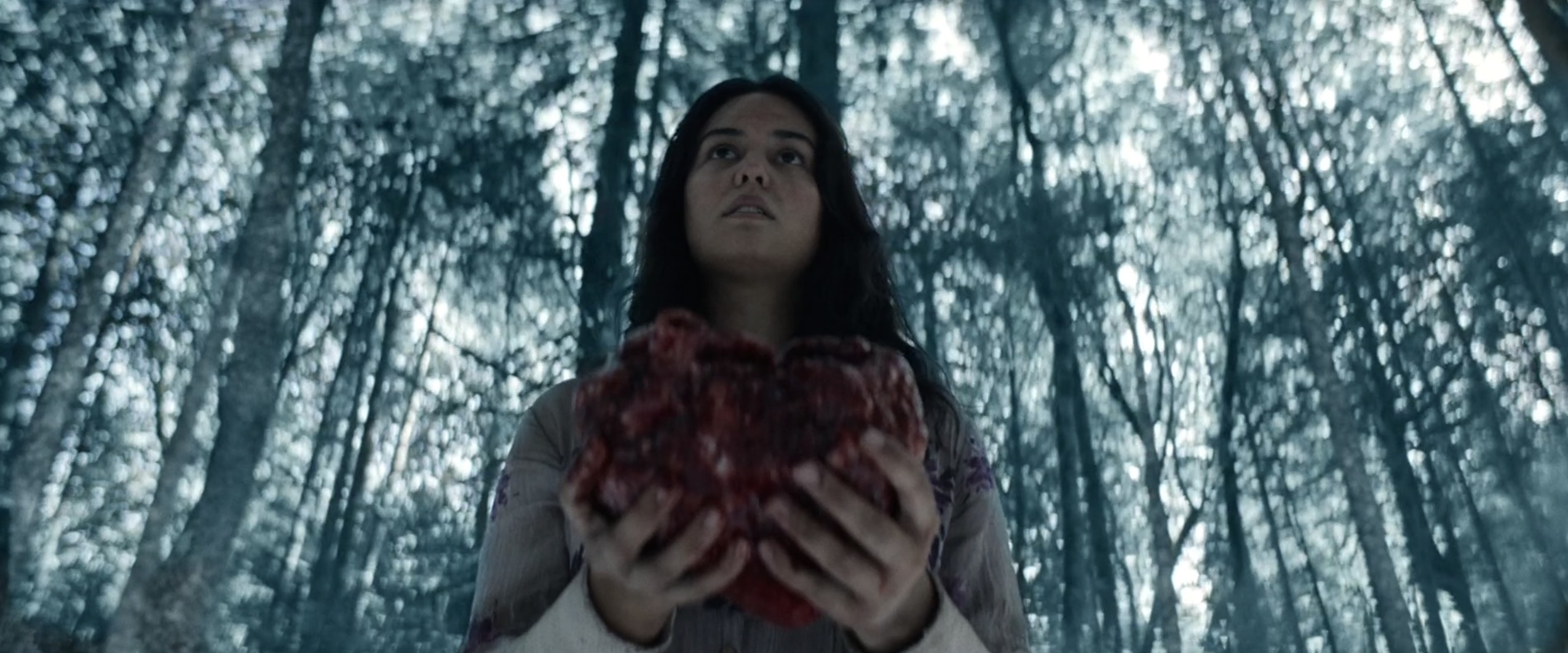
More mindfulness shows up in season two, episode five, but with a supernatural bend. As a strong winter storm blows through the girls’ settlement in 1997, Taissa and Shauna, who were caught outside the cabin, struggle to return to safety. They’re disoriented and Shauna begins to experience labor pains. Back at the cabin, the other girls shout their friends’ names, attempting to become sonic beacons. It won’t work. There’s too much noise from the harsh wind, and Lottie knows this. She places a hand on Van’s shoulder and, with her eyes closed, asks, “What do you hear?” Ever the skeptic, young Natalie shouts, “What the fuck does that have to do with anything?” But Van closes her eyes and says, “I hear the wind, I hear my breath, I hear the trees.” The camera cuts to Shauna and Taissa trying desperately to find the right path back to the cabin, and Taissa inexplicably begins to imitate Van, saying, “I hear my breath, I hear the wind, I feel my friends coming to find us.”
Again, it’s a legitimate exercise in remaining present and not panicking, but the introduction of wilderness magic, which seems to guide them back to the rest of the group, is difficult to really accept. “If it’s to, through mindfulness, maintain that sense of calm and peace, that’s great,” says Jensen of the chant. But, adds Jensen, “if Lottie’s trying to get them to ‘connect to the wilderness,’ that’s problematic” from a scientific perspective.
Intertwined with that segment from the ’97 timeline in episode five is a 2021 scene between grownup Natalie and grownup Lottie at Lottie’s compound. “This is a technique I learned during my time away,” says Lottie, referencing her stint in a psychiatric hospital after the Yellowjackets group was rescued. Sitting in front of Nat, who’s struggling to cope with Travis’ death, Lottie tells her to breathe and focus on a light she is flashing in her face. “Allow yourself to go back and picture the last time you saw Travis alive,” instructs Lottie. Nat closes her eyes and remembers snorting lines of cocaine with Travis and later overdosing. But she also sees a shadowy figure with antlers protruding from its head underneath a shroud, decorated in netting and walking through the plane crash site. Nat emerges from a trance-like state and tells Lottie, “The whole time, there was something, some darkness out there with us, or in us. It still is.”
The ’90s Songs We’d Love to Hear in “Yellowjackets” Season 2
These are the period-appropriate tracks we’d love to see turn up on the survival show’s next seasonIn this scene, Lottie is using a form of the eye movement desensitization and reprocessing (EMDR) method of treating post-traumatic stress disorder. EMDR is also used to remedy anxiety, phobias and other issues, and it works by “getting both hemispheres of the brain to be firing at the same time and connecting with each other,” says Jensen. Explaining further, Jensen says the theory behind EMDR, which is supported by research, is that sometimes memories of trauma “can get really stuck in a very specific center of the brain.” When that area of the brain is engaged it can create responses of anxiety and stress. EMDR, then, motivates the entire brain to work to “diffuse the memory” from its stubborn corner, and “get it to flow into general memory processing” to create “a different understanding” of the memory. This helps mitigate the lingering PTSD effects on the body — depression, anxiety, etc. — which arose because of the abnormal way the trauma memory was stored.
Michelle Giordano, who’s a community counselor and outreach specialist for Live Another Day, a mental health resource center, says the portrayal of EMDR and other mindfulness approaches that Lottie utilizes to help other characters in the show “may be oversimplified.” However, Giordano observes that “these methods can be useful tools for dealing with emotional issues when applied in a therapeutic setting and with expert supervision, [serving] as a reminder of the benefits of mindfulness and research-backed therapies in fostering emotional healing and personal development.”
“It can be an effective treatment,” Jensen says of EMDR. The viability of Lottie’s administration of it, however, is unclear to Jensen, though he does appreciate much of what goes on at Lottie’s commune, greater details of which were depicted in the most recent episode of season two.
The float therapy in a sensory deprivation tank that Misty undergoes is an activity that, for many, Jensen says, helps them arrive at “a place of mindfulness.” (Float therapy is something I’ve experienced myself and, after freaking out for a bit my first time, found it useful.) It can be “a stepping stone toward meditation in terms of, there’s no chance of any outside distractors” affecting the process, Jensen says. He discloses that people have reported mild hallucinations in sensory deprivation tanks, “like seeing colors or hearing wall sounds, but not quite to the extent” that Misty did in her Lynchian vision of showtune-dancing owls and a tophat-donning Elijah Wood.
Jensen also gives a thumbs-up to Lottie’s pet therapy offering, which adult Shauna engages in with the assistance of a rope-hungry baby goat. “We can feel unconditional love for [animals] and from them,” Jensen says, which may create a sense of purpose that can help lessen depression while boosting self-esteem. Caring for an animal also, again, opens up an avenue for mindfulness because the person undergoing pet therapy must focus on the task at hand, in the moment, i.e. grooming a dog or a horse.
“There are a lot of beneficial things that happen” at Lottie’s intentional community, Jensen says. “But I would support it more if it was more of a retreat than a commune.”
Jensen’s not in love with the idea that Lottie’s community members are totally separated from the outside world for an indefinite amount of time — though he sees benefits in people being out of contact with others for a while, like in some drug rehabs, as they commit more fully to working out their issues. And while generally Lottie appears to genuinely want to help people, Jensen wonders if she isn’t “preying on the most vulnerable” individuals around her. There also hasn’t been any indication as to whether or not Lottie has been properly trained and certified as a mental healthcare provider. That fact calls into question all of her alternative practices, which may have been honed only in response to her own horrific experiences in a psychiatric hospital. (We see her undergo electroconvulsive therapy, which is scientifically proven to help people living with schizophrenia, but is not depicted favorably in the series.)
Even the last act of “treatment” we see Lottie provide, this time to young Shauna in the cabin, arguably has some therapeutic value. After delivering a stillborn baby, Shauna grows increasingly angry at Lottie, believing her dalliances with the phantom spirits of the wilderness contributed to its demise. To the soundtrack of “Lightning Crashes,” by Live (another in a relentless string of amazing needle drops on this show), Lottie lets Shauna vent her rage by pummeling her. “I know there’s a lot of pain right now, but let it out,” Lottie says. “Shauna, we need you, let it out.” The beating commences and continues until Shauna is spent.
“I don’t see Lottie as having any malicious intent, but there are still some mindsets out there about physical aggression as a way to get out feelings of anger,” Jensen says. Those who have this mindset give credence to “catharsis,” which is defined by VeryWellMind in a medically reviewed post as “a powerful emotional release that, when successful, is accompanied by cognitive insight and positive change.” Less dangerous examples of this with potential benefits are journaling, listening to music, talking to a friend or exercise. But when it comes to allowances of aggressive behavior even in a controlled, safe environment — like the hitting of a pillow — many medical specialists don’t believe it does much more than make a person tired. (If anything, there’s evidence such actions may make a person even angrier.) That’s because, as Jensen and other specialists say, anger is not a primary emotion, but a secondary one that may instigate a physical response to a primary emotion.
“If you act out the anger, you’re missing the key emotion,” Jensen says. “That’s why it’s a problematic approach” from Lottie.
But it’s one that she seems all too eager to provide. At this point in the series she’s grown accustomed to shedding blood as a means of getting the attention of the spirits she trusts surround her. Watching the scene where Shauna bloodies her nose and much of her face, there’s a sense that Lottie’s sacrificing herself to an extent for the benefit of the group, which she hopes will now continually be cradled safely in the arms of the wilderness. We know many of them make it out of there alive, which is why adult Lottie — as well as Taissa and, now, increasingly, Nat and perhaps others from the group — might still be convinced of the power of the wilderness. Whether viewers are confident of its plausibility, even in the context of a fictional TV show, remains to be seen.
Through Simon, William Golding solved the mystery of “The Beast” in Lord of the Flies for his readers. It was all in the boys’ heads. We’ll find out just how much the Yellowjackets showrunners are inspired by the text — and how far they’re willing to go down this road of surrealism, anchored by the Lottie character’s beliefs, that might yet alienate an audience that’s so far feasted on its unadulterated realism.
This article appeared in an InsideHook newsletter. Sign up for free to get more on travel, wellness, style, drinking, and culture.
